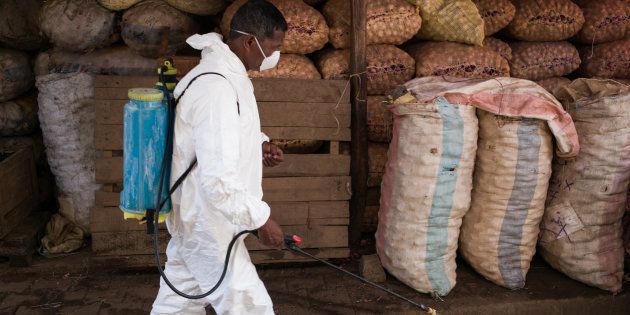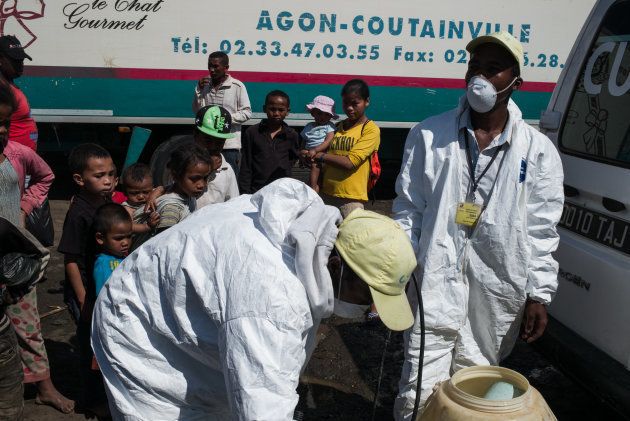
South Africa has been identified by World Health Organization (WHO) as one of nine countries that have been warned of a possible spread of 'the plague'.
Madagascar, which has travel and trade ties to South Africa, has experienced a recent outbreak of the disease... the same which struck terror in the hearts of medieval Europeans and is believed to have wiped out close to 60% of that continent's population centuries ago.
Plague is a serious disease with a death rate, if left untreated, of 30 to 100 percent within 72 hours, depending on the type of plague a patient has contracted. It has reportedly claimed 124 lives in Madagascar since 1 August 2017, with about 1,200 more suspected, probable or confirmed cases recorded so far.

Here's what you need to know about the plague:
1. It's an infectious disease
Plague is an infectious disease, caused by the bacterium Yersina pestis, found in some small mammals and transmitted by their fleas. It can be contracted if a person is bitten by infected fleas, in which case it develops as bubonic plague. However, pneumonic plague can be transmitted much more easily through the lungs.
2. Two major types of plague
There are two types of plagues most common in human infections: bubonic and pneumonic plague. The bubonic type, transmitted by flea bites, travels through the lymphatic system to the lymph nodes, where it replicates itself. The dark swellings, or "buboes", at lymph-node sites in the neck, armpits and groin, are what gives this form of plague its name
Pneumonic plague, as the name suggests, attacks via the lungs, transmitted in body fluids when infected patients cough or sneeze. While bubonic plague has a natural survival rate of 40-70 percent when left untreated, pneumonic plague is invariably fatal without the intervention of modern medicine.
3. Symptoms
People who contract the disease may experience sudden fevers, head- and body aches, nausea and vomiting. Painful and inflamed lymph nodes may also appear in bubonic plague. Those who have recently visited plague-risk areas, such as Madagascar, who begin to experience any of these symptoms should seek professional medical advice as soon as possible.
3. Pneumonic vs bubonic plague
Bubonic plague is not easily transmitted between people, but pneumonic plague can be spread rapidly through coughing and sneezing. Modern antibiotics cure plague efficiently, but they need to be introduced as early as possible, as plague can develop into a serious life-threatening condition rapidly.
4. Treatment
Plague is treated with antibiotics, and recovery is common if treatment starts early. In areas where there is a plague outbreak, people with symptoms should go to a health centre immediately for evaluation and treatment. Patients with pneumonic plague must be isolated and treated by trained medical staff wearing personal protective equipment.
Scary as the threat of plague may sound, given its morbid and devastating spread through Europe long ago, there may not really be much to worry about.
Speaking to TimesLive, Professor Lucille Blumberg -- consultant at the National Institute for Communicable Diseases -- said the disease hasn't spread across borders in three months. Furthermore, Blumberg noted, modern medicine, including treatment through antibiotics, is on our side and it is in fact Malaria that should worry us a lot more.
These are some additional facts about 'the plague' you may be interested in.
- In the 14th century, a succession of bubonic and pneumonic plague outbreaks killed almost two-thirds of the inhabitants of northern Europe -- with most victims succumbing within three or four days of infection.
- In 1347, residents of the Italian city state of Genoa shot fiery arrows at a ship returning from a war in the Black Sea, because it was known to be carrying bubonic plague.
- Despite this precaution, plague reached European shores and, in four years, killed 75-million Europeans -- often more than half the population of a given country.
- France and England suspended the Hundred Years' War (1337-1453) twice in the 14th century, because of Black Plague outbreaks.
- It was called the Black Plague because toes and fingers turn black as a result of the coagulation of the blood in them.
- No one knew at that time what caused it -- for many years people believed that the disease was spread by filthy air. Often cats -- whether household pets or feral -- were killed en masse as soon as plague appeared in a city, as they were blamed for this disease via their association with witchcraft and the devil. A sudden disappearance of all the cats, of course, resulted in an explosion in the rat population, which meant more fleas, and an even higher rate of infection.
- A third type of plague, septicaemic plague, also exists.
- Bubonic plague is the most common form, and also the most easily treated with modern antibiotics. Before treatment was available, it was the only form of plague people might survive through the natural strength of their immune systems.
Some information in this article appeared in an article published by Health24.
